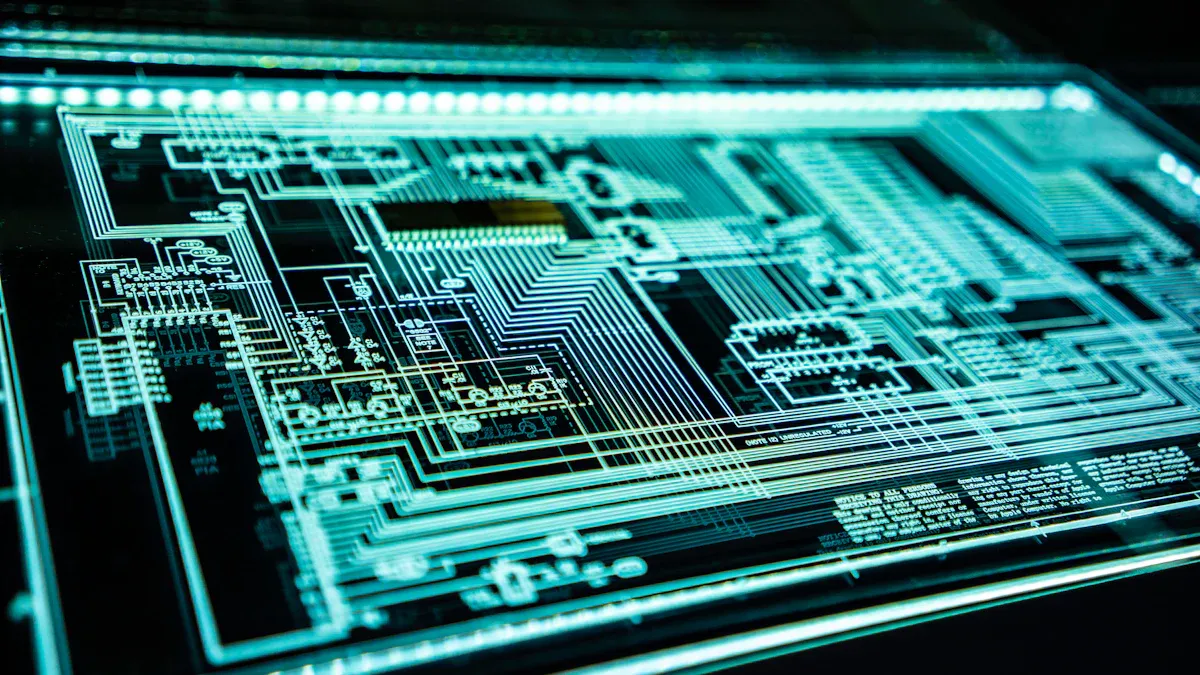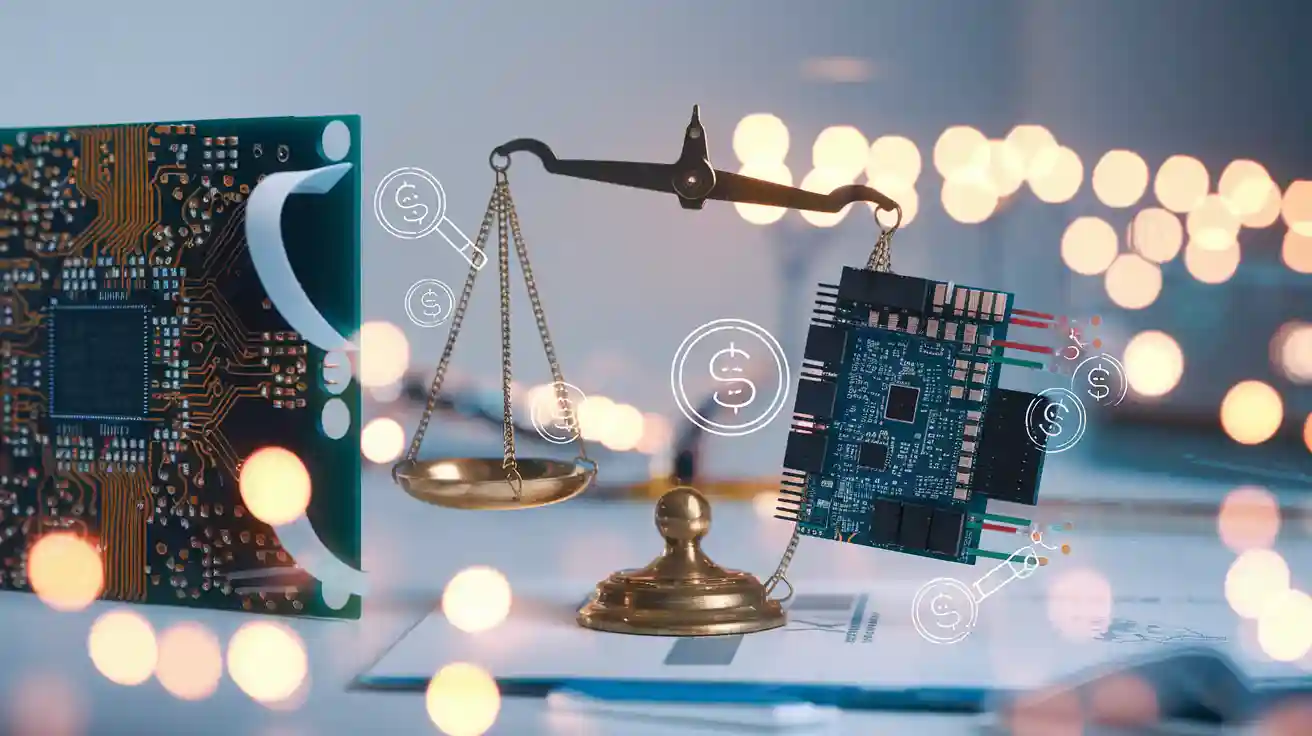Recent cost checks show complex flex pcbs can save money. They work best for simple or medium projects. Rigid-flex pcbs are better when you need both stiff and bendy parts. The price of a pcb depends on how hard it is to design. It also depends on how it is made and what it will be used for. Special features in complex flex pcbs or rigid-flex pcbs can make them cost more. Things like tiny lines or many lamination steps can raise the price by 50% to 200%. The table below shows the main things that change the price:
| Factor | Impact on Cost-Effectiveness |
|---|---|
| Design Complexity | More complex designs cost a lot more |
| Manufacturing Steps | More steps make the pcb cost more |
| Application Needs | Special needs make the total price go up |
Looking closely at these things helps engineers pick the best pcbs for saving money.
Key Takeaways
- Complex flex PCBs are cheaper at first. They are good for easy or medium jobs. These jobs need lots of bending and fit in small spaces.
- Rigid-flex PCBs cost more money. They give strong and steady boards. These boards have both hard and bendy parts. They are best for hard places and making many boards.
- The materials and steps to make PCBs change the price a lot. Using fewer layers and normal materials saves money. Simple designs also help save money.
- Working with makers early helps stop expensive mistakes. It makes the boards better and lowers the whole project cost.
- Picking the right PCB depends on how much it must bend. It also depends on space, how tough it needs to be, and how much money you have. This helps you get the best value and how well it works.
Cost Analysis Overview
Complex Flex PCBs Cost
Complex flex pcbs are a good choice for saving money in many electronics. The usual price for these pcbs is between $0.90 and $2.50 for each square inch if you use two layers. If you add more layers or want special features, the price can go up to $3.50 or even higher for each square inch. The main things that make the price go up are how many layers you use, if you need strong flex materials, and if you need careful drilling or cutting.
Making these pcbs is harder when you add more layers. More layers mean you need more materials and more time to make them. A six-layer complex flex pcb can cost 20% to 30% more than one with four layers. If you use different flex materials together, you need special glue and must line them up just right. These steps can make the price go up by 10% to 20%, especially if you need special thickness or materials. Drilling small holes called microvias costs two to three times more than regular holes. If you use fewer microvias or make them the right size, you can save 5% to 10% on drilling.
Testing and checking quality also add to the price. Complex flex pcbs often need to be bent and checked by machines to make sure they work well. If you design them to be easy to test and use machines for checking, you can save money on work. By knowing what makes the price go up, engineers can make better choices and keep the total cost lower.
Rigid-Flex PCBs Cost
Rigid-flex pcbs have both stiff and bendy parts in one board. This makes them strong and flexible, but they cost more. The normal price for a four-layer rigid-flex pcb is $3.00 to $5.00 for each square inch. If you want more layers, like six or more, the price can be $7.00 to $10.00 for each square inch. Rigid-flex pcbs usually cost 50% to 200% more than complex flex pcbs, depending on how they are made and what you need.
Many things make rigid-flex pcbs cost more. Putting stiff and bendy parts together needs special glue and careful lining up. If you use special materials or thickness, the price can go up by 10% to 20%. Plating and etching cost more because both the stiff and bendy parts must be covered the same way. If you use normal copper, you can save 5% to 8% on plating.
Drilling and cutting for rigid-flex pcbs, especially with microvias, can cost two to three times more than normal drilling. Using fewer microvias or making them the right size can help save money. Testing and checking quality are harder for rigid-flex pcbs. They need to be bent and checked more, which adds to the price. Using machines for testing can help save money and make more boards work well.
Note: The cost check shows that rigid-flex pcbs cost a lot more than complex flex pcbs, especially if you use more layers or special steps. But rigid-flex pcbs can save space and let you make cool designs, so sometimes the higher price is worth it.
If you know what makes the price go up, you can make smart choices. By making the design and building steps better, teams can get good performance without spending too much.
Key Cost Drivers
Materials
Materials are a big part of pcb costs. Flexible pcbs use polyimide films. These films cost more than the fiberglass in rigid boards. Polyimide films must bend and flex without breaking. They also need to handle heat well. Coverlay lamination and special drilling make materials cost more. Rigid-flex pcbs use both rigid and flex materials. This makes the board structure more complicated. The spots where rigid and flex meet need careful control. These areas also need extra layers. This makes material costs and labor needs go up.
| PCB Type | Material Cost Factors | Manufacturing Complexity | Cost Range (per sq. inch) | Impact on Total Project Cost |
|---|---|---|---|---|
| Flexible PCB | Uses expensive polyimide films; requires coverlay lamination and specialized drilling | Requires dedicated equipment and additional steps | $0.50 - $15.00 | 2-5 times higher cost than rigid PCBs; can reduce assembly costs by eliminating connectors but needs special handling |
| Rigid-Flex PCB | Combines rigid and flexible substrates; complex transition zones requiring precise control | Most complex manufacturing; lower yield rates due to complexity | $1.00 - $25.00 | Highest upfront material and manufacturing costs; improves reliability and integration; reduces lifecycle and warranty costs by eliminating connectors and simplifying assembly |
Rigid-flex pcbs have the highest material costs. This is because they mix two types of materials. These boards are more reliable and work better together. This can help save money over time. Flexible pcbs can also save money by not needing connectors. But they need to be handled with care and special tools. The materials you pick change the first cost. They also change how long the product lasts and how well it works.
Manufacturing Complexity
Making flex and rigid-flex pcbs is hard and costs more. Flexible pcbs need special machines for lamination, drilling, and cutting. Adding more layers or features like microvias adds more steps. This makes the total cost go up. Rigid-flex pcbs are even harder to make. They need more lamination, tighter rules, and careful lining up. These steps make mistakes more likely and lower the number of good boards.
Manufacturers must control the change from rigid to flex parts. This keeps signals strong and the board tough. Doing this needs good machines and skilled workers. More complex designs cost more to make. Assembly takes longer when boards are complex. Workers must be careful not to break the flex parts. This careful work adds to labor costs and slows down making the boards.
Tip: Make the design simple and use fewer layers to save money. Pick standard materials and skip extra features to keep costs low.
Yield and Assembly
Yield and assembly change the total pcb cost a lot. Yield means how many good boards you get from each batch. Complex flex and rigid-flex pcbs often have lower yields. This is because their designs are tricky. Every extra step can cause more mistakes. Lower yield means higher costs for each good board.
Assembly for flex and rigid-flex pcbs has good and bad points. Flexible pcbs can save money by not needing connectors or cables. This makes the product lighter and more reliable. Rigid-flex pcbs put all parts on one board. This makes them even more reliable and lowers the chance of broken connections. It also makes assembly easier, which can save time and money for big projects.
- Rigid-flex pcbs are strong and can bend. This makes them reliable for things like planes, cars, and medical tools.
- Flexible pcbs need special care and tools during assembly. This can make labor cost more but helps signals stay strong.
- Both types can save money in the long run by using fewer connectors and cables.
Teams must weigh the good parts of better reliability and working together against higher starting costs and harder making steps. Looking closely at yield and assembly helps teams pick the right pcb for their job.
Complex Flex PCBs vs. Rigid-Flex PCBs

Application Scenarios
Engineers pick complex flex pcbs or rigid-flex pcbs for each project’s needs. The best choice depends on space, price, how much it bends, and how well it works. The table below shows how each type fits different jobs:
| Aspect | Complex Flex PCBs | Rigid-Flex PCBs |
|---|---|---|
| Cost-effectiveness Scenario | Saves money in small batches, places with shaking, and tiny spaces | Saves money in factories needing both bending and stiff parts |
| Flexibility | Bends and folds a lot, good for wearables, drones, robots, car sensors, and medical wearables | Has stiff and bendy parts, lets you connect things in tricky ways but stays strong |
| Typical Application Environments | Used in small, shaky, tight spots like wearables, drones, and medical wearables | Used in tough places like factories, where things bend a bit and need to last (robot arms, control panels, sensor modules) |
| Reliability and Durability | Helps stop connector problems and stands up to shaking | Very strong, uses fewer connectors, and lasts through heat and chemicals |
| Volume Considerations | Good for making a few at a time when the first price is okay | Better for making lots because it is tough and can be tricky to design |
Rigid-flex pcbs are great for small spaces where you need to fold and bend, like robot arms and small control boxes. They also make things lighter by not needing extra connectors or wires, which is good for stuff you carry. Complex flex pcbs work best in things that must bend a lot and shake, like wearables and drones. These pcbs can bend over and over and fit in tiny places, so they are perfect for medical wearables and car sensors.
Value Considerations
When you compare value, you need to look at more than just the first price. Rigid-flex pcbs have stiff and bendy parts, so they are strong and can handle tough places. They last longer and break less because there are fewer weak spots, like solder joints and connectors. This means you pay more at first, but you save money later, especially in hard jobs.
Complex flex pcbs use stuff that does not crack or peel, so they work well when things move a lot. They get rid of many connectors and wires, which keeps signals strong and stops breaks over time. These good things help the product last longer, even if the first price is higher. Flex pcbs also let you make things thinner and lighter, so you save space and can change the design more.
Note: Small spaces and how well things work are big reasons to pick one type. Rigid-flex pcbs can take more heat and let you put parts close together in powerful, tiny things like satellites. Complex flex pcbs are best when you need to bend a lot and fit into small places.
Picking the right pcb means thinking about price, how strong it is, and what the job needs. Teams should match the pcb to where it will be used, how long it should last, and what it must do to get the most for their money.
Reducing PCB Cost
Design Optimization
Engineers can save a lot of money by making smart design choices. They make the pcb layout simple and use fewer layers. Fewer layers mean less material and easier making. Using regular board sizes and parts keeps costs down. Teams try to use fewer vias and pick through-hole vias instead of microvias. This cuts down on steps and saves money.
If teams follow Design for Manufacturability rules, they avoid mistakes and fixes that cost more. Working with manufacturers early helps find ways to save money later. Planning to order more boards after testing can lower the price for each one. Not rushing orders also helps get better prices. All these steps help save money and make the boards work better.
- Make the circuit simple and use fewer layers.
- Pick regular sizes and parts.
- Use fewer vias and keep routing easy.
- Follow DFM rules.
- Work with manufacturers from the start.
- Order more boards at once and plan ahead.
Material Choices
Picking the right materials changes how much you spend now and later. Polyimide films and coverlay laminates bend well but cost more than FR-4. If you do not need special features, use cheaper materials to save money. Where you get materials matters too. Hard-to-find materials like clear polyimide cost more and are harder to use.
Manufacturers check the bill of materials and look for risks when picking parts. They check if parts are easy to get and use reviews to pick the best ones. Choosing materials that handle heat and bend well stops breaks and keeps costs low. These choices help keep the board flexible and save money over time.
- Use regular materials when you can.
- Only use special laminates if you must.
- Work with suppliers to get good parts.
- Make the design use materials well.
Manufacturing Tips
Making changes in how you build pcbs can save a lot of money. Using special materials made for flex boards, like adhesiveless laminates, helps them bend and handle heat. Teams follow rules for how much the board can bend and do not put vias or pads where it bends. This stops damage.
Making the board stack-up even and marking where rigid and flex parts meet stops warping. Working with makers early helps plan the stack-up, improve yield, and use panelization. This means fewer mistakes and less fixing later. Using panelization tricks, like breakaway tabs, makes handling and assembly easier. Giving clear instructions and working with makers from the start keeps things smooth and costs low.
Tip: Talk to manufacturers early to stop costly mistakes, make sure you get parts, and save money in the long run.
Alternatives to Rigid-Flex
Rigid PCBs
Rigid PCBs are still used a lot in electronics. They use normal materials and easy steps to make. This makes them simple to build and put together. If a device does not need to bend, rigid PCBs work well and do not cost much. The table below shows how different PCB types compare for wearables:
| PCB Type | Cost Factors and Characteristics |
|---|---|
| Rigid PCBs | Cheaper to make because the process is simple and uses fewer connectors; assembly is quick and easy; less fixing needed, so the total price is lower. Good for bigger devices that do not need to bend. |
| Soft (Flexible) PCBs | Cost more because they use special materials like polyimide and need harder steps to make; this makes the final product cost more. |
| Rigid-Flex PCBs | Cost more than rigid PCBs because they mix stiff and bendy parts and are harder to make; they use fewer connectors and solder spots, so they last longer and let you make smaller, lighter, and more comfy devices. |
Rigid PCBs cannot bend or fold after they are made. This means they cannot be used in small or moving things. But they are easy to put together and help stop mistakes.
Semi-Flex Options
Semi-flex PCBs are between rigid and rigid-flex types. They have a stiff base and a thin part that can bend a little. This lets them bend some when you put them in. Semi-flex PCBs cost 20-50% more than regular rigid PCBs but are still 20-30% cheaper than full rigid-flex boards. They are good for things that need to bend a bit, like medical tools or car controls.
- Semi-flex PCBs can bend a little.
- They are easier to make than rigid-flex PCBs.
- Working with makers early and using old designs can save money.
Semi-flex PCBs are stronger because they need fewer connectors and cables. They give you some bend but are still simple.
Other Solutions
Other choices are using rigid PCBs with bendy cables or making the device in parts. These ways can make the first price lower and make fixing easier. But they can make the device bigger and harder to put together. For easy jobs, single-layer or double-sided flexible PCBs give some bend at a lower price. These are good for cheap and simple products.
Note: Picking the best type depends on how much the product needs to bend, how much space there is, and how strong it must be. Teams should pick the right kind for the job to get the best results.
Complex flex PCBs often cost less at first. Rigid-flex designs last longer and work better in tough places. Teams should pick the PCB type that fits their project and budget. This helps save money and get good results. Working with manufacturers early helps make better choices. You can pick the right stack-up, materials, and design for better boards.
- Check if the manufacturer can meet your needs and has good quality
- Make the design simple and use common materials
- Order more boards at once and plan for longer wait times










 2025-08-05
2025-08-05
 BEST
BEST


.png)
.png)
.png)
.png)

.png)

